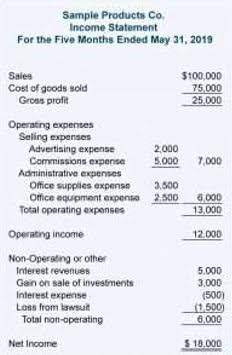Content

This negates the need to affect your sales tax liability account. Save money without sacrificing features you need for your business. As a refresher, debits and credits affect accounts in different ways. Assets and expenses are increased by debits and decreased by credits.

Each entry increases accounts receivable and increases sales. Entries that affect accounts payable are posted daily to the individual subsidiary ledger accounts, and creditor account numbers are placed in the cash disbursements journal’s reference column. Entries in the Other column are posted individually to the general ledger accounts affected, and the account numbers are placed in the cash disbursements journal’s reference column. A capital Xis placed below the Other column to indicate that the column total cannot be posted to a general ledger account. The sales journal is where you record all credit sales of stock, inventory that is sold for credit and not cash. The sales journal is a type of sub-journal that you keep separated so that the general journal doesn’t get so cluttered. If we had to log every single transaction in the general journal, things would get out of hand pretty quickly.
How do you correct an Internal Sales Journal that was previously approved and posted to the General Ledger with a mistake in it? Corrections are a three-step process for which the seller is responsible. This article describes a three-step process to correct an Internal Sales Journal that was previously approved and posted to the General Ledger. In other words, goods are the commodities that are purchased and sold in a business on a daily basis. Goods are denoted as ‘Purchases A/c’ when goods are purchased and ‘Sales A/c’ when they are sold.
Sales Journals
Both account numbers are placed in the general journal’s reference column to indicate that the entry has been posted correctly. Transactions that decrease cash are recorded in the cash disbursements journal. The cash disbursements journal to the right has one debit column for accounts payable and another debit column for all other types of cash payment transactions. It has credit columns for purchases discounts and for cash. Since each entry debits a control account or an account listed in the column named Other, the specific account being debited must be identified on every line. A Sales Journal documents only the sales that a customer makes on credit.
Some businesses keep a different purchase and sale journal, while some journals keep the record of purchases and sales in the same journals. The six main parts of a sales journal are Data, account Debited, Invoice number, post Reference, Accounts Receivables, and cost of goods sold. It should be noted that sales of goods are recorded in the sales journal. However, sales of assets such as land, building, and furniture are not recorded in the sales journal because they are sold infrequently. It is used for maintenance and tracking of the account receivable account and inventory accounts. It increases the burden of accounting work on an entity because an entity can also identify the credit sale transaction from the Account receivable account.
This is one of the journal’s greatest advantages because a person can quickly locate all of the business’s sales on an account. The purchases journal lists all credit purchases of merchandise. Entries in this journal usually include the date of the entry, the name of the supplier, and the amount of the transaction.
Many companies use a multi‐column sales journal that provides separate columns for specific sales accounts and for sales tax payable. Each line in a multi‐column journal must contain equal debits and credits. For example, the entries in the sales journal to the right appear below in a multi‐column sales journal that tracks hardware sales, plumbing sales, wire sales, and sales tax payable. Notice the dates and posting references applied to each entry in the illustration to the right. Each day, individual sales journal entries are posted to the accounts receivable subsidiary ledger accounts so that customer balances remain current.
Step 1: Find And Copy The Original Posted Journal
A special or specialized journal to record sales of merchandise to customers. In a manual system this saves a significant amount of recording time. In today’s computerized environment, sales are recorded automatically when the sales invoice is generated. Similarly, purchase journals are used to record the purchases of a company. Cash payment journals record the cash payments made by the clients of a company. Sales journals record sales and some other particular metrics related to sales.
- Such transactions can be documented on one line in a special journal.
- In purchase and sale books/journals the net purchase or sale value after deducting trade discount from the total value of goods is shown.
- Now, let’s say your customer’s $100 purchase is subject to 5% sales tax.
- For help with more complex scenarios, contact Accounting Services at
- Account ReceivablesAccounts receivables is the money owed to a business by clients for which the business has given services or delivered a product but has not yet collected payment.
Entries in the Other column are posted individually to the general ledger accounts affected, and the account numbers are placed in the cash receipts journal’s reference column. A capital X is placed below the Other column to indicate that the column total cannot be posted to a general ledger account. Transactions that increase cash are recorded in a multi‐column cash receipts journal. If sales discounts are offered to customers, the journal includes a separate debit column for sales discounts.
The identification number mentioned in the invoice allows helping track down that particular sale. By the same amount, and debited the cost of goods sold by $ 3,75,000.00 and credited the inventory Account.
What Are The Advantages Of Using A Sales Journal?
An accountant or bookkeeper records cash or immediate payment transactions in the cash receipt journal, not in the sales journal. Here is an example of how accountants or bookkeepers use sales journals. The accountant or bookkeeper enters the date, sales number, and the customer’s name in the appropriate columns. In the accounts receivable column, she enters the total amount receivable from the customer. The total amount minus the sales tax goes in the sales credit column, and the sales tax goes in the sales tax payable column. When the accountant or bookkeeper posts the entry to the general ledger — usually at the end of the month — she will put a check mark in the post. The sales journal lists all credit sales made to customers.

Ageneral journalto record adjusting and closing entries and any other entries that do not fit in one of the special journals. Note that we included GST in our sale, but now we have to separate it from the sale price. Also, we will have a debtors’ control account that lists ALL the credit we’ve given to customers. We have to include the full value of the sale here because that is what they owe us. All credit sale transactions entered are supported with invoices. So, the discount allowed GL account would be part of the transactions. Purchase of assets on credit, the stock of goods at the year-end, rectification of errors, adjustment of accounts, etc. are recorded in journal proper.
Want More Helpful Articles About Running A Business?
The special journal, where the credit sale returns are recorded, is called a sales return journal. The sales return journal is prepared from debit notes sent by the buyer with returned goods. For instance, Pyle and Larson have shown credit purchase of assets and supplies, etc. in a purchase journal under a separate column – debiting asset or office supplies and crediting accounts payable. Information detailed in the journal includes the invoice number, batch number, date, customer number, terms, freight, sales tax, and net and total amounts. To create the sales journal entry, debit your Accounts Receivable account for $240 and credit your Revenue account for $240.
- When seller sells merchandise on credit, he prepares an invoice known as sales invoice or outward invoice.
- Sellers might be reluctant to refund the already received money.
- Transactions are primarily recorded in the journal and thereafter posted to the ledger.
- The Sales Journal in the Excel file contains a list of twenty saes on credit transactions.
In this case, we would post a $200 debit to merchandise inventory and a $300 debit to utility expense. Under the periodic inventory method, the July 6 shipping costs would go to a Transportation In account and the July 25 discount would go to Purchases Discounts. A column for the transaction date, account name or customer name, invoice number, posting check box, accounts receivable amount, and cost of goods sold amount.
We Are Checking Your Browser Quizletcom
Therefore, the journal, wherein the transactions which cannot be directly recorded in a particular journal are recorded, is called journal proper. That is why in modem times the use of many journals instead of one journal has been introduced in almost all business concerns, especially the medium and large size business concerns. During the update, the software runs through one update that posts to both the module’s master and history files and to the General Ledger. Error correction entries are not saved by the software if the user cancels before the updated confirmation takes place.
Offering credit to customers implies that they’ll be receiving goods without paying for them immediately. Because of this, a different method of recording sales has to be used.
The total of cost of goods sold & inventory column is debited to cost of goods sold account and credited to inventory account in the general ledger. The; special journal used for recording various transactions relating to cash payment is called a cash payment journal. The special journal used for recording all types of cash receipts is called the cash receipts journal.

For example, taking a loan from a bank, interest receipts, the cash sale of assets, etc. Sales journal is used for recording the credit sale of merchandise only.
The Format Of The Purchase Journal:
Since the sales journal is used exclusively to record credit sales, the last column (i.e., the amount column) represents both a debit to accounts receivable and a credit to sales. A sales journal is used to record the merchandise sold on account. Any entry relating to the sale of merchandise for cash is recorded in the cash receipts journal. The total of accounts receivable & sales column is debited to accounts receivable account and credited to sales account in the general ledger. The nature of each company’s transactions determines which columns this journal includes.
Now, let’s say your customer’s $100 purchase is subject to 5% sales tax. Your customer must pay you $5 ($100 X 0.05) in sales tax. DateAccountNotesDebitCreditX/XX/XXXXCashXRevenueXRealistically, the transaction total won’t all be revenue for your business. You can see how these journal entries would be recorded in the general ledger as by clicking fooz ball townto save space.
- It involves accounting methods and practices determined at the corporate level.
- Some even allow you to instantly make an accounting entry from a sales invoice.
- It does more than record the total money a business receives from the transaction.
- Be sure to save the most recently modified Sales Journal as an audit trail of invoiced receivables.
- The transaction number, account number, customer name, invoice number, and sales amount are typically stored in the sales journal for each sale transaction.
When you offer credit to customers, they receive something without paying for it immediately. DateAccountNotesDebitCreditX/XX/XXXXCashXSales Tax PayableXRevenueXYour debit and credit columns should equal one another. July 30 Sold $7,000 of merchandise inventory, terms 1/15, n 30, FOB Shipping point with cost of goods sold $5,000 to Bobby Blue. July 5 Sold $5,000 of merchandise inventory, terms 1/15, n 30, FOB Destination with a cost of goods sold of $3,000 to Robby Red.
Cash Receipts Journal
Your task is to complete the Sales Journal by analysing each transaction and deciding in which account column it must be placed. The Sales Journal in the Excel file contains a list of twenty saes on credit transactions. If the Enable Bill To Customer Reporting is selected in Accounts Receivable Options, the bill-to customer number and name is included on the journal. The Sales Journal can be printed by batch if the Allow Batch Entry for Invoicing check box is selected in Accounts Receivable Options. The following totals are from the Invoice Ship To record.
The Post Ref. column in the subsidiary ledger and controlling accounts is labeled SJ-1 to represent page 1 of the sales journal. Postings to the subsidiary ledger should be made daily to ensure that management has up-to-date knowledge about how much each customer owes. The sales journal has five columns to record the necessary information relating to credit sales. Here, the term sales refers to the sale of only those goods or merchandise in which the business normally deals. The sale of used or outdated assets (such as old plant, machinery, equipment and newspapers etc.) are not recorded in sales journal.
To overcome these entire limitations multi-column cash receipts journal is required. In modem age, the introduction of cash receipts journal is in practice in medium and large size business organizations. The transactions of the same nature are recorded in a special journal. These are termed as a daily journal, subsidiary journal or special journal. Be sure to save the most recently printed https://www.bookstime.com/ as an audit trail of invoiced receivables, cash sales, and adjustments.
When seller sells merchandise on credit, he prepares an invoice known as sales invoice or outward invoice. This invoice is sent to the customer, usually along with the merchandise. This duplicate copy is kept by the seller with him because the entry in the sales journal is made on the basis of it.
0 Comments